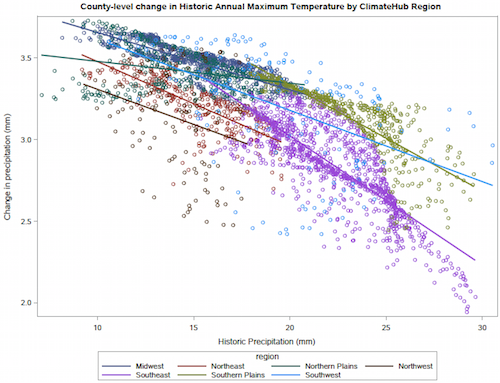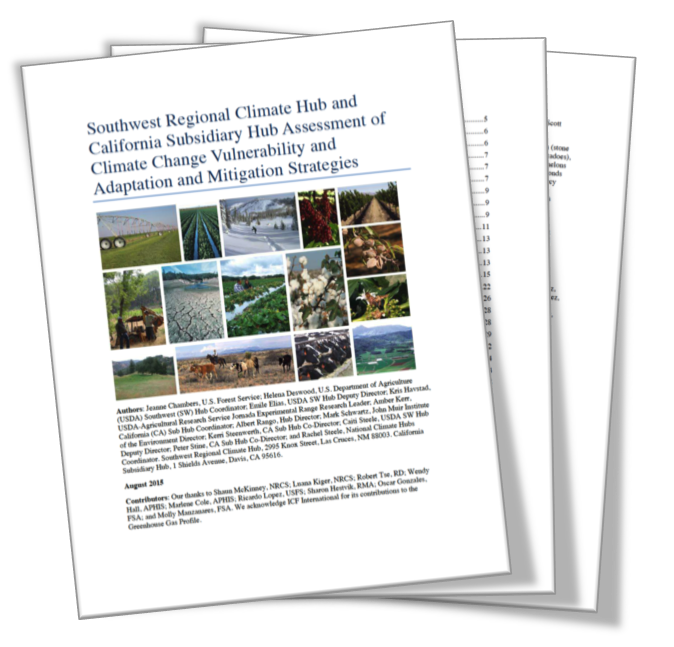- Data
- Videos
-
Publications & Research
-
Education
- Water Conservation Data Jam - Curriculum for 6th-12th Grade Students
- Climate Change and Wildfire – Curriculum Unit for 9-12 Grade Students
- Climate Change and the Carbon Cycle – Curriculum Unit for 9-12 Grade Students
- Where's Our Water? Water Conservation in the Southwest - Lesson for 6-8 Grade Students
- Climate Change and the Water Cycle - 10-Hour Curriculum Unit for 6-12 Grade Students
- The Effects of Climate Change on Agricultural Systems - 5-Hour Curriculum Unit for 6-12 Grade Students
- Cambio climatico y el ciclo del agua
- Webinars and Online Courses
- Websites
- News & Events
- About Us
- RMA
Addressing a Decreasing Snowpack in the Southwestern U.S.A.
Scientific researchers generally agree that the average annual water storage capacity of mountain snowpacks (or snow water equivalent) in the southwestern United States is decreasing and will continue to decrease in the decades to come. According to the National Climate Assessment, the average annual amount of precipitation in these states might not change much in the coming decades, but more of the precipitation at all elevations will come as rain rather than snow. Instead of large natural mountain snowpack “reservoirs” which release liquid water all spring and much of the summer, winter rains will cause streamflows to increase during the winter and decrease during the spring and summer. This is one of the major challenges for water resources—both for water quantity and quality in our rivers and lakes—and for the communities that depend on these resources.
One way that Extension can address this fact is to increase our emphasis on proper management of our watersheds and our riparian (streamside) environments. This was one of the conclusions of water specialists at the 2016 Southwest Extension Climate Science Workshop in Tucson, Arizona. It was agreed that careful watershed management and protection of floodplains and riparian areas will become even more important as the climate changes.
A basic principle of watershed health is to keep the water on and in the land at all elevations as long as possible each year. In natural drainages with healthy river channels, floodplains, and riparian zones, the soil and wetlands act as natural “sponges” that keep water from running rapidly downstream after rainstorms. However, many rivers and streams in the West are not so healthy. Many rivers have channels that have “downcut” into valley floors, leaving unvegetated, vertical streambanks. Such “incised streams” have little healthy riparian habitat, and groundwater storage is reduced because the adjacent valley aquifer drains to the new, lower level of the streambed. This dries out much of the sponge associated with the stream. While healthy streams receive inflow from stored groundwater long after most snow has melted, unhealthy streams dry up much sooner each spring. This is especially problematic for downstream users such as farmers and fish.
One interagency program that addresses the health of our watersheds and their water storage capacity is called Riparian Proper Functioning Conditions (PFC) assessment. This interagency educational program teaches land managers how to assess the current conditions of riparian areas and streams within the context of their watershed or water catchment. Through science-based interdisciplinary assessment, each perennial or intermittent riparian area can be rated as to whether it is properly functioning, at risk, or not functioning. This assessment provides information to managers and landowners about how to restore the stream through improved management that allows self-healing.
Integrated with keeping water in and on the land longer is keeping carbon in the soil longer. Soil carbon reaches extraordinary levels in properly functioning riparian areas and wetlands. And, soil carbon is extremely effective in promoting infiltration, absorbing water and nutrients, and making these resources available to plants and other organisms. When riparian areas or wetlands lose functions, they export their stored carbon through decomposition while the soil becomes less effective as a sponge.
In Nevada, PFC Assessment is being applied by an interdisciplinary team led by Extension Range and Riparian Specialist, Dr. Sherman Swanson. The program is called, “Creeks and Communities: A Continuing Strategy for Accelerating Cooperative Riparian Stewardship.” Sherm and his team offer classes to increase cooperation with all landowners on a watershed scale. Proper Functioning Condition (PFC) Assessment promotes the use of common terms, definitions, and methods. It has proven useful in identifying opportunities with a high probability for positive change from a reasonable investment, while enhancing management and problem solving at the local level by the people most affected. The Creeks and Communities team won a 2017 national merit award from the Soil and Water Conservation Society for teaching diverse audiences about the creeks they depend on and care for.
Author: John Cobourn, University of Nevada Reno
You can learn more about this program by going to: http://naes.unr.edu/swanson/Extension/PFCTeam.aspx.
You can reach Dr. Swanson at: sswanson@cabnr.unr.edu.









